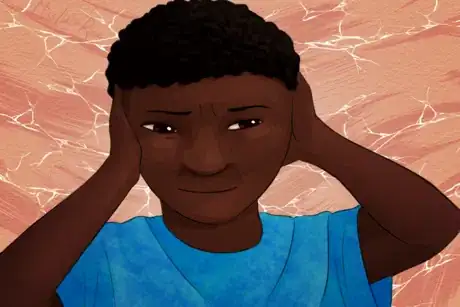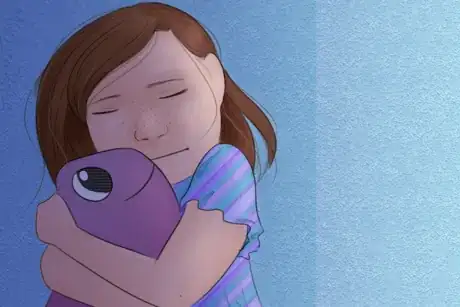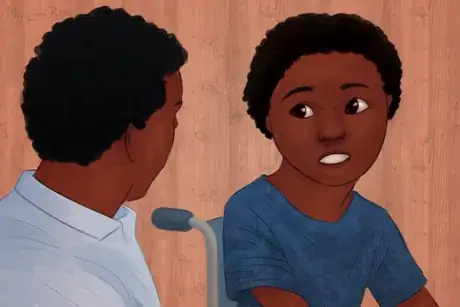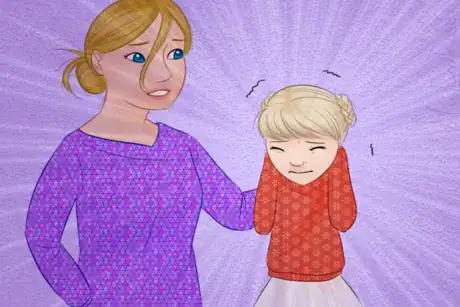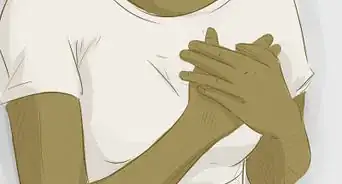This article was co-authored by Salina Shelton, LPC, MA. Salina Shelton is a Licensed Professional Counselor, specializing in Art Therapy in San Antonio, Texas. She received her MA in Counseling from The University of Texas at San Antonio in 2013 and her Certificate in Expressive Arts Therapy from Prescott College in 2015
There are 17 references cited in this article, which can be found at the bottom of the page.
This article has been viewed 22,664 times.
When a child or teenager talks about hurting themselves or taking their life, don’t dismiss them – they may not be just looking for attention. Suicide is the third leading cause of death for children between the ages of 10 and 14, and it’s the second leading cause of death for teens and young adults from 15 to 24.[1] Keep your kids safe by taking the risk of suicide seriously. You can do so by educating yourself about the risk factors for suicide in children, knowing which warning behaviors to look for, and talking to your child about suicide. If you believe your child in immediate danger of attempting suicide, call or text the Suicide and Crisis Lifeline at 988.[2]
Steps
Knowing the Risk Factors
-
1Be vigilant if your child has attempted suicide before. A previous suicide attempt is one of the biggest indicators that a child may try again in the future. Even if your child seems to be doing better now, they are still at risk, so keep an eye on their behavior and ensure they are getting any mental health care they need.[3]
-
2Consider whether your child has any mental health disorders, or developmental disabilities. Children who have been diagnosed with anxiety, depression, a conduct disorder, schizophrenia, autism, Oppositional Defiant Disorder, ADHD, or bipolar disorder are at increased risk for dying by suicide. The risk increases even more if a child has co-occurring disorders, or more than one mental health diagnosis.[4]
- If you think your child may have a mental health disorder or mental disability, take them to the doctor so they can get a diagnosis and appropriate care.
Advertisement -
3Think about whether your child has been under stress lately. A stressful home life can increase a child’s suicide risk. So can difficulties at school or with friends. If your child seems to be struggling to cope with events in their life, keep a close eye on them for other warning signs of depression or suicidal behavior.[5]
- Factors that increase stress at home include the death of a family member (especially by suicide), a divorce, or abuse.
- If your child’s grades are slipping, they talk about not wanting to go to school, or they no longer spend time with their friends, it could signal that they are having problems at school.
-
4Find out whether your child is involved in bullying. Bullies and their victims are both at increased risk for suicidal behavior. Ask your child whether bullying happens at their school, and keep an eye out for indicators that your child may be a victim or a perpetrator.
- Victims of bullying may act anxious about going to school, have unexplained injuries, or seem to lose or break their possessions frequently.
- Aggressive, quick-tempered children are more likely to be bullies.
-
5Question whether your child is struggling with their sexual orientation. LGBTQ young people are at increased risk for having mental health problems and taking their life.This is particularly true when their family or community is not supportive of their orientation.[6]
- Take note of your child's media usage and TV/film preferences to look for hints that they aren't sure about their sexual orientation.
- You might also start a dialogue with your child about LGBT+ topics by using a scene from a television show or movie. Ask, "They seem to genuinely care for one another. How do you feel about people of the same gender being in love? Is that something that comes up at school?"
-
6Consider the child’s family history. A child who has a family member who attempted or died by suicide is at a higher risk of attempting suicide themselves.[7] Think about the child’s family history to determine if this might be a risk factor.
Identifying the Warning Behaviors
-
1Notice whether your child seems preoccupied with death. If your child talks about death, says they want to die, or makes other vague references to death such as “going away,” they may be suicidal. Writing or drawing about death or the afterlife is also a red flag.[8]
- Even very young children may express suicidal thoughts, but they might express themselves in a less obvious way, such as by saying something like, “I just want to float away.”
-
2Look out for changes in personality and behavior. A suicidal child may start acting in strange or uncharacteristic ways. If your outgoing child becomes withdrawn and quiet, they may be in trouble. Similarly, a cautious child might start acting reckless or defiant if they’re thinking about suicide.[9]
-
3Notice whether your child gives possessions away. If your child starts giving their belongings away, they may be planning suicide. Pay particular attention if they start getting rid of items they previously treasured, or if they say they won’t need their possessions anymore.[10]
- Start a dialogue by saying, "Jessie, you gave your lucky baseball glove away to Rob. What made you do that?"
-
4Pay attention to acts of saying goodbye to loved ones. If your child is thinking about taking their life, they may say goodbye to friends and family members as if for the last time. They may also arrange to visit loved ones they haven’t seen in a while.[11]
- Goodbye letters are another major warning sign that your child may be suicidal.
-
5Keep an eye on your child’s sleeping and eating habits. Kids who are depressed may sleep too much or suffer from insomnia. They might also lose their appetite or overeat, which can cause changes in weight.
- You might say, "Joey, you don't seem to have much of an appetite lately. Want to talk to me about that?"
- You can also ask them how they have been feeling lately. Ask them about their energy levels, sleep, appetite, feelings, etc.
-
6Take reckless or self-harming behavior seriously. Suicidal kids and teens may injure themselves or do dangerous things, such as driving recklessly, using drugs, or engaging in unsafe sex. If you find out your child is doing any of these things, seek help for them right away.[12]
Talking to Your Child
-
1Pay attention to any threats or warnings. If your child talks about dying or expresses feelings of hopelessness, talk to them. Don’t brush off their comments or assume they’re just being dramatic.[13]
- While many of the kids and teens who talk about suicide never attempt it, the risk is too great to ignore. Even if your child doesn’t intend to take their life, the fact that they brought it up still indicates that they are in pain and need professional help.
- Say, "You said that you want to die. It sounds like you are dealing with some really big stuff. Could you tell me more about how you are feeling?” If they aren't open to talking, you might add, "As your parent, I have to take comments like that seriously. If you don't want to talk to me, I think I will set up an appointment for you to see a counselor. How does that sound?"
-
2Express your concern to your child. Bring up the warning signs you’ve noticed. Let your child know that you care about them and want to help them. If they tell you they’ve been struggling, empathize with them and encourage them to seek professional help.[14]
- For instance, you could open the conversation by saying, “I’ve noticed that you seem really sad and withdrawn lately, and I’m worried about you. Do you want to talk about anything?”
- Let your child know that they don’t have to be ashamed of seeking help. Say something like, “I know it’s hard to believe now, but you don’t have to keep feeling like this. Talking to a therapist will help you feel a lot better.” Make sure that your child has a therapist that they trust and feel comfortable talking with. If they are not comfortable with their therapist, then look for a new one.
-
3Stay calm. You might feel scared or helpless, but avoid letting your emotions get the better of you when you talk to your child. They will be more likely to open up to you if you stay levelheaded and calm.[15]
- Avoid making your child feel judged or criticized. This will make them clam up, and it could worsen any feelings of guilt they’re having.
- It is a good idea to normalize what your child is feeling. Try saying something like, “Lots of people experience depressed moods from time to time. It is important to talk to someone about it, so let’s find a therapist who can help.”
-
4Ask questions. Guide the conversation and help your child open up by asking gentle questions about how they have been feeling. If your child avoids the topic of suicide, bring it up by saying something like, “Have you been thinking about trying to kill yourself?” Being this direct can be a little scary, but it is important to be direct and open so that you can make it okay for your child to be direct and open about what they are feeling.[16]
- Gain further info that can determine how severe your child's suicidal thoughts are. This may include asking "Have you thought about how you would do that?" to see if they have an actual plan. If the child says yes, then you need to seek immediate medical attention for them.
-
5Ask the child which problems they're struggling to cope with. While sometimes depressive/suicidal thoughts are only caused by chemical imbalances in the brain, environmental factors often play a role. If the child is feeling overwhelmed by certain problems, this may be part of the cause, and helping them handle these problems can reduce the need for a "way out."
- Listen and validate their feelings to help them know that you care and take their problems seriously.
-
6Help your child get treatment. Take your child to a doctor or counselor for an evaluation, regardless of whether you think they are actually planning suicide or not. If your child admits to planning suicide, take them to the emergency room for immediate help.[17]
- Do not leave your child alone if you think they are planning to die by suicide.
References
- ↑ https://www.cdc.gov/nchs/fastats/adolescent-health.htm
- ↑ https://988lifeline.org/
- ↑ https://www.headspace.org.au/assets/School-Support/Identifying-risk-factors-and-warning-signs-for-suicide-web.pdf
- ↑ https://onlinelibrary.wiley.com/doi/pdf/10.1111/j.1553-2712.2007.tb02357.x
- ↑ http://www.cheo.on.ca/uploads/18887_18228_Suicide_ENG.pdf
- ↑ https://childmind.org/article/teen-suicides-risk-factors/
- ↑ https://www.cdc.gov/violenceprevention/suicide/riskprotectivefactors.html
- ↑ https://www.health.ny.gov/prevention/injury_prevention/children/fact_sheets/10-19_years/suicide_prevention_10-19_years.htm
- ↑ http://www.merckmanuals.com/home/children-s-health-issues/mental-health-disorders-in-children-and-adolescents/suicidal-behavior-in-children-and-adolescents
- ↑ http://www.mayoclinic.org/healthy-lifestyle/tween-and-teen-health/in-depth/teen-suicide/art-20044308?pg=2
- ↑ https://www.helpguide.org/articles/depression/teen-depression-signs-help.htm
- ↑ https://www.helpguide.org/articles/suicide-prevention/suicide-prevention-helping-someone-who-is-suicidal.htm
- ↑ https://www.healthychildren.org/English/health-issues/conditions/emotional-problems/Pages/Ten-Things-Parents-Can-Do-to-Prevent-Suicide.aspx
- ↑ https://www.apa.org/about/governance/president/suicidal-behavior-adolescents.pdf
- ↑ http://www.huffingtonpost.com/christy-espositosmythers/teen-suicide-prevention_b_3333486.html
- ↑ http://kidshealth.org/en/parents/suicide.html#
- ↑ http://www.stanfordchildrens.org/en/topic/default?id=teen-suicide-learning-to-recognize-the-warning-signs-1-1696

